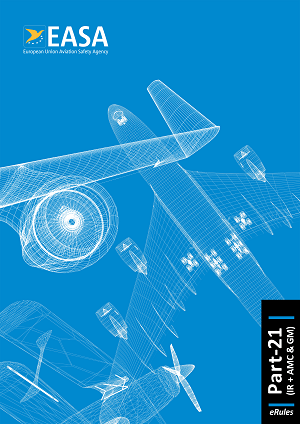Regulation (EU) 2022/1361
(a) Section A of this Annex (Part 21 Light) establishes the provisions governing the rights and obligations of the following persons having their principal place of business located in a Member State:
1. the applicant for, and holder of, any certificate issued or to be issued in accordance with this Annex;
2. natural and legal persons declaring, in accordance with this Annex, design compliance, design capabilities or production capabilities, or intending to make such declarations;
3. the signatory of a statement of conformity for an aircraft, or an authorised release certificate (EASA Form 1) for an engine, propeller or part produced in accordance with this Annex.
(b) Section B of this Annex establishes the provisions governing the certification, oversight and enforcement by the Agency and national competent authorities in accordance with this Annex and establishes requirements for their administration and management systems relating to the exercise of these tasks.
Regulation (EU) 2022/1361
For the purpose of this Annex, ‘competent authority’ shall be:
(a) for Section A, Subpart A,
1. for design organisations, the Agency;
2. for a production organisation, the authority designated by the Member State where the organisation has its principal place of business; or the Agency, if that responsibility has been reallocated to the Agency in accordance with Article 64 or 65 of Regulation (EU) 2018/1139;
(b) for Section A, Subparts B, C, D, E, F, J, K, M, N, and Q, the Agency;
(c) for Section A, Subparts G, H, I and R, the authority designated by the Member State where the organisation has its principal place of business; or the Agency, if that responsibility has been reallocated to the Agency in accordance with Article 64 or 65 of Regulation (EU) 2018/1139;
(d) for Section A, Subpart P:
1. for aircraft registered in a Member State, the authority designated by the Member State of registry;
2. for unregistered aircraft, the authority designated by the Member State which prescribed the identification marks;
3. for the approval of flight conditions related to the safety of the design, the Agency.
ED Decision 2023/013/R
RESPONSIBILITY FOR IMPLEMENTATION
Each certificate or registration of a declaration of capability in accordance with Part 21 Light Section A Subparts G, H, I, P and R is normally issued and overseen by the competent authority of the Member State in which the natural or legal person is located. Therefore, to ensure consistency between the competent authorities of the Member States in issuing certificates and registering declarations of capability, the implementation of Part 21 Light should be based on the following three principles:
(a) The establishment and maintenance of an effective organisation and the corresponding processes by all competent authorities.
(b) The operation of all the competent authorities in accordance with Part 21 Light and the acceptable means of compliance (AMC) and guidance material (GM) thereto; and
(c) A standardisation process that is established and applied by EASA to assess the standard(s) achieved, and to provide timely advice and guidance to the competent authorities.
As a result, the responsibility for implementation consists of two main objectives:
(d) to ensure that certificates and registration of declarations of capability are only granted to natural or legal persons that comply with the requirements of Part 21 Light; and
(e) to ensure that there is sufficient visibility of the processes to give the Agency and the Member States the necessary confidence in the certificates granted or the capability of natural or legal persons that have a registered declaration of design or production capability or use Subpart R for production.
ED Decision 2023/013/R
PERMIT TO FLY
An aircraft registered in a Member State is under the responsibility of that Member State regarding continuing airworthiness aspects. Consequently, permits to fly under Part 21 Light may be issued by that Member State, including any cases in which the aircraft flies in another State. The permit to fly contains all the conditions and restrictions to ensure safe flight, but other airspace and operational rules remain within the competence of the authority of the State where the flight takes place, and may apply. Therefore, the applicant is also required to ensure compliance with the relevant applicable regulations of that State.
